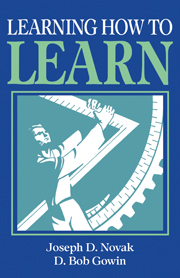Book contents
- Frontmatter
- Contents
- Foreword
- Preface
- Acknowledgments
- 1 Learning about learning
- 2 Concept mapping for meaningful learning
- 3 The Vee heuristic for understanding knowledge and knowledge production
- 4 New strategies for instructional planning
- 5 New strategies for evaluation: concept mapping
- 6 The use of the Vee for evaluation
- 7 The interview as an evaluation tool
- 8 Improving educational research
- Appendixes
- References
- Index
4 - New strategies for instructional planning
Published online by Cambridge University Press: 05 June 2012
- Frontmatter
- Contents
- Foreword
- Preface
- Acknowledgments
- 1 Learning about learning
- 2 Concept mapping for meaningful learning
- 3 The Vee heuristic for understanding knowledge and knowledge production
- 4 New strategies for instructional planning
- 5 New strategies for evaluation: concept mapping
- 6 The use of the Vee for evaluation
- 7 The interview as an evaluation tool
- 8 Improving educational research
- Appendixes
- References
- Index
Summary
This chapter will illustrate strategies for using concept mapping and Vee diagramming for planning a total curriculum program (e.g., a B.S. degree in social work) as well as specific instructional activities (e.g., tomorrow's lesson in math). All too often, educational theory is of no help when it comes to planning tomorrow's lesson. We will try to illustrate how concept mapping and Vees can help educators design not only their next lesson, but their total instructional program as well.
We will sketch only a few of the potential uses of these ideas for instructional planning. We hope that readers will venture beyond our examples and test, evaluate, and criticize the application of these strategies in other areas of educating, and we would welcome communication with educators about successes or difficulties.
THE USES OF CONCEPT MAPPING
For major curriculum planning, concept mapping is the key pedagogical strategy we wish to advance. As indicated in Chapter 2, it is possible to organize concept maps either for an entire educational program or for part of a simple lesson. It is necessary to use a variety of levels of concept inclusiveness: broad, integrative concepts should be the basis for planning the curriculum for a given course of study, whereas more specific, less inclusive concepts serve as guidelines for selecting specific instructional materials and activities. Put another way, the top of a disciplinary concept map guides major curriculum planning activities, whereas the lower portion implies specific instructional activities, including the specific events or objects to be studied.
Information
- Type
- Chapter
- Information
- Learning How to Learn , pp. 77 - 92Publisher: Cambridge University PressPrint publication year: 1984
